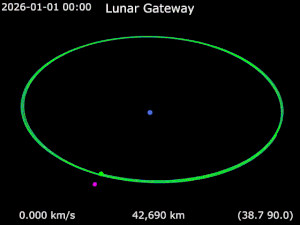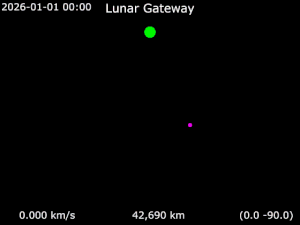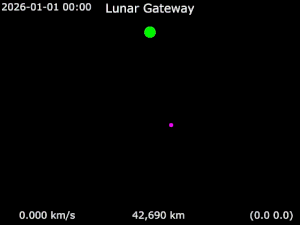Near-rectilinear halo orbit

In orbital mechanics a near-rectilinear halo orbit (NRHO) is a halo orbit that passes close to the smaller of two bodies and has nearly stable behavior.[1] The CAPSTONE mission, launched in 2022, is the first spacecraft to use such orbit in cislunar space, and this Moon-centric orbit is planned as a staging area for future lunar missions. In contrast with low lunar orbit which NASA characterizes as being deep in the lunar gravity well, NRHO is described as being "balanced on the edge" of the gravity well.[2]
The NRHOs are a subset of the L1 and L2 halo families.[3] This orbit type could also be used with other bodies in the Solar System and beyond.
Association with Lagrange points
[edit]
A halo orbit is a periodic, three-dimensional orbit associated with one of the L1, L2 and L3 Lagrange points. Near-rectilinear means that some segments of the orbit have a greater curvature than those of an elliptical orbit of the same maximum diameter, and other segments have a curvature less than that of an elliptical orbit of the same maximum diameter (taking maximum diameter as that of the smallest circle that contains the whole of the orbit).[citation needed] In the extreme case all segments have zero curvature with four points with infinite curvature (i.e. a polygon). An NRHO requires at least two other bodies (e.g. the Earth and Moon), and thus NRHO orbits are one theoretical solution to the classic three-body problem in gravitational mechanics. Of the three bodies, one is taken to be of negligible mass (the spacecraft).
There are four families of NRHO orbits associated with the L1 and L2 points, two each in the northern and southern directions.[4][5] The low perilune orbits are nearly polar. They are nearly stable, minimizing the artificial thrust required for station-keeping.
Previous and current NRHO missions
[edit]CAPSTONE
[edit]By 2022, the company Advanced Space built a 12-unit cubesat to fly on a Gateway precursor mission for NASA. Named CAPSTONE (Cislunar Autonomous Positioning System Technology Operations and Navigation Experiment), the spacecraft became the first spacecraft to operate in an NRHO lunar orbit from 14 November 2022 after launch on 28 June 2022.[6][7] The mission objective is to test and verify the calculated orbital stability planned later for the Lunar Gateway space station, and the spacecraft will fly the identical orbital parameters planned later for Gateway. It will also test a navigation system that will measure spacecraft position relative to NASA's Lunar Reconnaissance Orbiter (LRO), without relying on ground stations.[8]
Lunar Flashlight
[edit]NASA/JPL's Lunar Flashlight, a cubesat intended to search for water near the lunar south pole, was also planned to use a near-rectilinear halo orbit,[9] but the satellite failed to reach the NRHO.[10]
Planned NRHO usage
[edit]Lunar Gateway
[edit]
By 2018 NASA had begun considering use of a near-rectilinear halo orbit for a future lunar mission,[11][12] and by 2020 an Earth-Moon L2 NRHO had become the planned orbit for the NASA Lunar Gateway. The Gateway orbit will be a 9:2 resonant NRHO,[13] with a period of about 7 days and a high orbital eccentricity, bringing the station within 3,000 kilometers (1,900 mi) of the lunar north pole at closest approach and as far away as 70,000 kilometers (43,000 mi) over the lunar south pole.[14][15][8]
Artemis 3
[edit]In 2020 NASA refined its plans for the crewed Artemis 3 mission to the lunar surface, removing its dependence on the Lunar Gateway while retaining the planned use of a NRHO for orbital rendezvous between the Orion spacecraft and a lunar lander.[16]
Notes
[edit]- ^ Whitley, Ryan J.; et al. (2018). "AAS 18-406 EARTH-MOON NEAR RECTILINEAR HALO AND BUTTERFLY ORBITS FOR LUNAR SURFACE EXPLORATION" (PDF).
- ^ Nujoud Merancy (June 2023). "How: NRHO - The Artemis Orbit" (PDF). NASA.
- ^ Spreen, Emily; et al. (May 2017). "NEAR RECTILINEAR HALO ORBITS AND THEIR APPLICATION IN CIS-LUNAR SPACE". IAA.
- ^ "Orbit Maintenance and Navigation of Human Spacecraft at Cislunar Near Rectilinear Halo Orbits". NASA Technical Reports Server. 5 Feb 2017. Retrieved 17 Nov 2022.
- ^ "Near Rectilinear Halo Orbit". 28 March 2020.
- ^ Tavares, Frank (31 May 2022). "CAPSTONE Spacecraft Launch Targeted No Earlier Than June 13". NASA. Retrieved 1 June 2022.
- ^ "CAPSTONE launch delayed to March 2022". 13 October 2021.
- ^ a b Foust, Jeff (16 September 2019). "NASA cubesat to test lunar Gateway orbit". SpaceNews. Retrieved 15 June 2020.
- ^ JPL/NASA (November 28, 2022). "NASA's Lunar Flashlight SmallSat readies for launch".
- ^ Foust, Jeff (August 9, 2023). "Clogged propellant lines doomed NASA lunar cubesat mission". SpaceNews. Retrieved August 10, 2023.
- ^ NASA Shapes Science Plan for Deep-Space Outpost Near the Moon, space.com, March 2018.
- ^ How a New Orbital Moon Station Could Take Us to Mars and Beyond, space.com, October 2017, video with refs
- ^ Parrish, Nathan; et al. (5 Jan 2020). "Near Rectilinear Halo Orbit Determination with Simulated DSN Observations" (PDF). American Institute of Aeronautics and Astronautics. doi:10.2514/6.2020-1700.
The current nominal orbit for the Gateway is a 9:2 synodic resonant southern L2 NRHO
- ^ Angelic halo orbit chosen for humankind's first lunar outpost, European Space Agency, published by PhysOrg, 19 July 2019, accessed 15 June 2020.
- ^ Halo orbit selected for Gateway space station. David Szondy, New Atlas. 18 July 2019.
- ^ Jeff Foust (14 May 2020). "NASA refines plans for launching Gateway and other Artemis elements". SpaceNews.
References
[edit]- Howell, K. C. (1984). "Almost Rectilinear Halo Orbits". Celestial Mechanics. 32 (1): 29–52. Bibcode:1984CeMec..32...29H. doi:10.1007/BF01358402. S2CID 119855471.
External links
[edit]- Angelic halo orbit for Gateway (video), ESA, 17 July 2019. The planned Lunar Gateway orbit appears a bit like a halo around the Moon from the point of view of an observer on the Earth.



